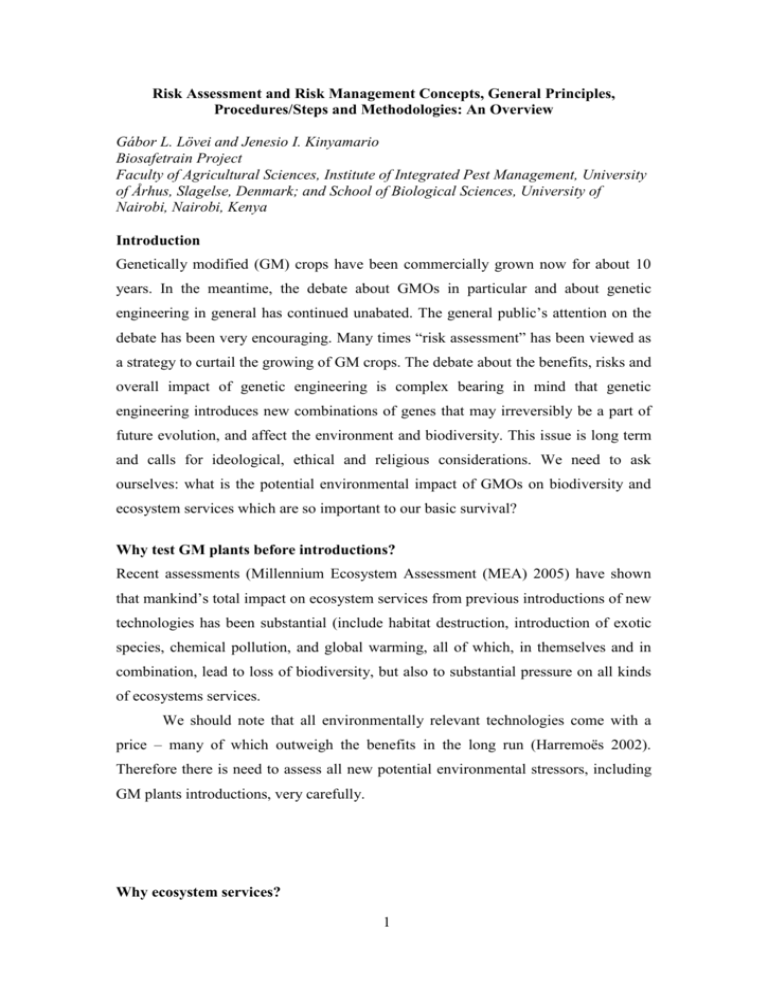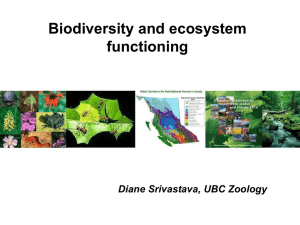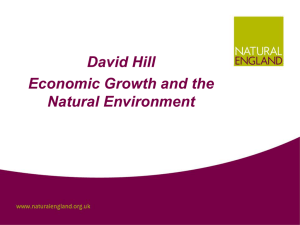Risk assessment and risk management concepts, general principles
advertisement

Risk Assessment and Risk Management Concepts, General Principles, Procedures/Steps and Methodologies: An Overview Gábor L. Lövei and Jenesio I. Kinyamario Biosafetrain Project Faculty of Agricultural Sciences, Institute of Integrated Pest Management, University of Århus, Slagelse, Denmark; and School of Biological Sciences, University of Nairobi, Nairobi, Kenya Introduction Genetically modified (GM) crops have been commercially grown now for about 10 years. In the meantime, the debate about GMOs in particular and about genetic engineering in general has continued unabated. The general public’s attention on the debate has been very encouraging. Many times “risk assessment” has been viewed as a strategy to curtail the growing of GM crops. The debate about the benefits, risks and overall impact of genetic engineering is complex bearing in mind that genetic engineering introduces new combinations of genes that may irreversibly be a part of future evolution, and affect the environment and biodiversity. This issue is long term and calls for ideological, ethical and religious considerations. We need to ask ourselves: what is the potential environmental impact of GMOs on biodiversity and ecosystem services which are so important to our basic survival? Why test GM plants before introductions? Recent assessments (Millennium Ecosystem Assessment (MEA) 2005) have shown that mankind’s total impact on ecosystem services from previous introductions of new technologies has been substantial (include habitat destruction, introduction of exotic species, chemical pollution, and global warming, all of which, in themselves and in combination, lead to loss of biodiversity, but also to substantial pressure on all kinds of ecosystems services. We should note that all environmentally relevant technologies come with a price – many of which outweigh the benefits in the long run (Harremoës 2002). Therefore there is need to assess all new potential environmental stressors, including GM plants introductions, very carefully. Why ecosystem services? 1 Ecosystem services are ecological processes that cannot be replaced by current technologies which operate on vast scales from which we derive substantial benefits. These services include production of goods such as fish and timber, generation of soils and maintenance of soil fertility, decomposition, detoxification of wastes, clean environments, mitigation of climatic extremes, biological control of potential pests, weeds and pathogens, and crop pollination. Though ecosystem services were treated as inexhaustible, high increases in human populations and their use of natural resources have reached a point where ecosystem services show clear signs of strain. Agriculture Agriculture is a human activity with a huge “ecological footprint” (Wackernagel and Rees 1997), and has a crucial role in global ecology, especially in driving many aspects of environmental quality. The Ecological Footprint measures people’s natural resource consumption. The footprint can be compared with nature’s ability to renew these resources Due to this, agricultural activities impact heavily on ecosystem services, in terms of pesticides, carbon and water balances, changes in natural biodiversity including plants, animals and microbes, etc. Biodiversity Biodiversity is viewed as crucial to the functioning of ecological systems (Loreau et al. 2002), but the important question is: just how vital? Basic functions of biodiversity include some of the following, not in any order of importance: 1. Impact on productivity A more diverse ecological community will produce a higher biomass than a less species-rich one (Loreau et al. 2002). More species can utilize the available resources more efficiently, but there are some key species that have disproportionate influence (Wardle and van der Putten 2002). 2. Insurance against change Under stable conditions, most biodiversity is redundant for ecological functioning in terms of energy efficiency. However, factors that seem redundant under one set of conditions may become necessary if conditions change, since the organisms have to adapt. Conditions changes occur naturally, for example through climate change such as global warming, and due to human activities such as introduction of exotic species. These may impact on the functioning of ecological systems. 2 3. Providing ecosystem services Ecosystem services are linked to points 1 and 2 above. Concerns about biodiversity Agriculture and other human activities have had significant impacts on global biodiversity, especially in regard to introduced species. Through historic times, intentional introductions of species deemed useful or merely desirable at new locations have been made and these have had had particularly broad impacts. Their effects, often considered beneficial, have had numerous unwanted, significant negative effects (Baskin 2002). Together with unintended introductions, invasions have become a significant problem, and an element of global change (Vitousek et al. 1997), including increasing homogenization of the distribution of species on Earth (Lövei 1997) leading to breakdown of biogeographical barriers that results in reduced global biodiversity (Vitousek et al. 1997). Ecosystem services Ecosystem services are ecological processes beneficial to humankind and are irreplaceable with current technologies. They ensure agricultural productivity, including soil formation, decomposition of plant residues, pollination, and natural pest control. They also include removal of waste products through detoxification, decomposition, air and water purification; contain numerous valuables to humans and human culture; provision of aesthetic beauty, cultural and spiritual inspiration, scientific discovery, and recreation. We have to consider these services in any GM plants impact assessments. Hence, GM crops and their potential impact on ecosystem services must be tested for any negative impacts (Lövei 2001). Modern high-input agricultural practices use several external inputs that at least partially replace ecosystem services (fertilizers, pesticides, irrigation, and even pollination) but these external inputs are often not available to farmers in many developing countries, hence these farmers have to rely more on natural ecosystem services. Since GM crops will be grown outdoors, in contact with surrounding ecosystems, and they certainly have the potential to substantially modify current agricultural practices (Hawes et al. 2003), their impacts on ecosystem services will have to be examined thoroughly and critically (Hails 2002). 3 Incorporating ecosystem services into risk/impact assessment Including ecosystem services into a GMO risk/impact assessment possess several fundamental challenges: structure and function in relevant ecosystems and food-webs have to be recognized, e.g. predator-prey relationships that keep a number of pests under control and also where productivity may depend on insect pollination services (e.g. cotton); significant functional links must be established where structure and function are reasonably well understood for example, it may turn out that pollination is much more significant than pest control for productivity in the ecosystem where a GM crop is to be introduced. Most important species fulfilling identified relevant ecological roles that should be subjected to pre-release testing have to be identified without forgetting that even the most important functions will typically be performed by numerous species, for example pollination services may be provided by more than 30 bee species, but the most important could be just one, or a handful of them. Pre-release testing should focus on these functionally important species and when such species are identified, suitable testing and monitoring methods must be developed for them. If there is no option to identify species responsible for the execution of important ecological services, for instance, the case with most soil micro-organisms, the relevant processes must be identified and a potential adverse impact of the GMO tested. Where there may not be suitable laboratory systems or field monitoring methods available for these functional processes, or such tools are lacking, these should be developed. Current regulatory regimes for GM Plants Does the current regulatory testing actually address the issues of GMO impacts on ecosystem services? Currently applicants applying for approval of GM plants follow basic guidelines originally developed for testing the environmental effects of chemicals (pesticide model). The strategy used in ecotoxicology testing of chemicals is to expose single species (standard set) to single chemicals in a hierarchical tiered system. Tests commence with simple inexpensive range finding tests on single species and measure acute toxicological response to a chemical stressor. If first-tier experiments yield results of concern, that proceeds to more expensive higher tiered levels (including some chronic toxicity tests). For example, in the case of a GM plant producing the Bacillus thuringiensis toxin, microbially produced Bt-toxins (Bt plant) 4 are fed directly to testing organisms (bi-trophic exposition) in an experimental set-up originally developed to assess acute toxicity of synthetic chemicals. Acute toxicity measures the physiological toxicological response of an organism after being directly exposed to the isolated test substance within a short period of time (normally hours rather than days). This pesticide model as a testing guideline for insecticidal GM plants is problematic for a number of reasons. For one, plants are different from chemicals: i) In GM plants, the plant-expressed transgene product is an integral component of the whole plant and may be expressed essentially in all plant parts throughout the entire growing season depending on the promoter. It is also coupled to its metabolism leading to variable expression levels of the transgene product that is additionally modulated by environmental conditions, including seasonal changes in temperature, soil type, moisture, and light. When compared with pesticides, this is equivalent to a long persistence of the pesticidal substance and an almost complete coverage of the plant. ii) The other fundamental difference to chemicals is also that GM plants are capable of self-reproduction. Because of this capability, biological traits and organisms can increase in the environment and potentially spread and exist for unlimited time. In contrast, chemicals cannot reproduce and, thus, their absolute amount will, at best (or worst), remain stable for a long time, but over time will always decline. Most disappear due to degradation. iii) GMOs and their transgene products can actively spread. In addition, all passive mechanisms of spread for chemicals also apply to transgene products released into the environment from the living GM plants (e.g. exudates, leaching from living and dead material). The potential of human-aided spread of seeds, plants and animals should not be underestimated (Baskin 2002) 5 Table 1: Some standardized guidelines for ecotoxicological testing of pesticides and GMOs (OECD 2006). Test organism Test method Duration OECD Guideline No. Water fleas, Daphnia Acute 24-96h 202 immobilization/toxicity 24-96h 203 Fish sp. (rainbow trout) Acute toxicity 7-14d 207 Eisenia foetida (compost worm) Acute toxicity 4-24h 213 & 214 Honey bees Acute toxicity (oral and contact) http: ecb.jr.it/testing-methods, www.oecd.org/dataoecd/9/11/33663321.pdf It is therefore more difficult if not impossible to determine the exact exposure concentrations in a given environmental compartment for GM plants as compared to chemical toxins. In contrast, chemical pesticides applications in the field are controlled by the applicator, including the timing, the point location, etc. Degradation begins immediately after application and the mode of action is typically acute (also affects non-target species). Therefore a scientifically sound testing strategy and methodology for GM plants require case-specific risk assessment and must account for the whole transgenic organism. It must also treat a GM plant within an integrated biological system consisting of the plant, the novel trait and the receiving environment. Test organisms selection Test organisms must be of same trophic levels because the test substance is often not ingested directly by higher trophic level organisms but is ingested via one or several intoxicated prey species. We know that persistent chemicals, such as DDT, can accumulate and even become more toxic along the food chain, meaning that they can reach concentrations and toxicity levels that, at the end of the food-chain, are multifold above the levels originally introduced into the ecosystem. Research on insectplant interactions has shown that insects can use toxic proteins in their host plants to turn them into defence mechanisms against their enemies. For example, the monarch butterfly (Danais plexippus) larvae accumulate an alkaloid from the host plant, milkweed, which makes them unpalatable. It is not known how herbivore species, 6 which are not affected by novel transgene compounds, may be using them against their enemies. These complications make it currently unlikely that a few selected species could universally be used for pre-release risk assessment of GM plants. Test materials In toxicological and ecotoxicological testing of pesticidal GM plants, high concentrations of the microbially produced transgene product, e.g. the Bt-toxin, are applied. However, toxicity depends on the size of the Bt-toxin molecule released after being cleaved by trypsin to create the toxic fragments of different size (Höfte and Whiteley 1989; Müller-Cohn et al. 1996; Andow and Hilbeck 2004). This means that the Bt-toxins expressed in GM plants may vary significantly in size and activity from the test substances used to assess safety, i.e. in standard toxicological and ecotoxicological testing. As we have pointed out earlier, a GM plant is not a chemical and any environmental testing must therefore account for the difference. Test strategies must be case-specific and should include the transgene product, the transformed plant and the environment of deployment as an integrated system. This is even more important in the case of GM plants that do not express a toxin, but have, for example, an altered metabolism (e.g. herbicide tolerant plants). In these cases, the adoption of test principles from chemical testing is even less relevant because environmental effects of these GM plants may become evident on other levels altogether. A new approach for environmental impact testing Conceptual frameworks on GM plant impact assessments have been proposed (see for example Hill, 2005). Hill correctly noted that the methodology was adapted from the existing paradigm for environmental risk assessment, which was developed for chemicals and other type of environmental stressors. This framework included 5 steps: i) Hazard identification, ii) Exposure assessment, iii) Consequences assessment, iv) Risk characterization, and v) Mitigation options (that fed back to previous steps). 7 Conceptual and methodological uncertainties of studying the ecological effects of GM crop plants on non-target arthropods have raised several interesting general problems. i) What species or ecosystem functions should be chosen to test? ii) By what routes might these species or functions be exposed directly or indirectly to GM crop plant products? iii) How can meaningful scientific hypotheses be constructed to provide rapid assessments of the magnitude of the potential risks? In contrast to toxicological and ecotoxicological methods for addressing these problems, assessment of the impacts of GM crop plants must be case specific and contextualized to the environment in which they will be used. The approach should combine ideas and methods from a “community approach”, which emphasizes analysis of intact biodiversity, a “functional approach”, which emphasizes community reactions, a “key species approach”, which emphasizes the individuality of species, and an “indicator species approach”, which is central in ecotoxicological testing. The process should rank and select species into functional groups (herbivores, decomposers, natural enemies, and pollinators), and allow the identification and prioritization of non-target species for some key ecological groups. It should also reflects the current state of knowledge and expertise available, and identify gaps in knowledge and uncertainties. References Andow, D.A. and Hilbeck, A. (2004) Science-based risk assessment for non-target effects of transgenic crops. Bioscience, 54: 637-649. Baskin, Y. (2002) A plague of rats and rubber vines. Island Press, Washington, D.C. 330 pp.Bøhn, T. and Amundsen, P. A. (2004) Ecological interactions and evolution: Forgotten parts of biodiversity? – Bioscience, 54: 804-805. Hails, R.S. (2002) Assessing the risks associated with new agricultural practices. Nature, 418, 685-688. Harremoës, P., Gee, D., MacGarvin, M., Stirling, A., Keys, J., Wynne, B. and Guedes Vaz, S. (2002): Late lessons from early warnings: the precautionary principle 1896-2000. – 22. – Copenhagen, Denmark (European Environment Agency): 211 S. Hawes C, Haughton AJ, Osborne JL, et al. (2003) Responses of plants and invertebrate trophic groups to contrasting herbicide regimes in the Farm Scale Evaluations of genetically modified herbicide-tolerant crops. Philosophical 8 Transactions of The Royal Society of London Series B-Biological Sciences, 358: 1899-1913. Hill, R.A (2005) Conceptualizing risk assessment methodology for genetically modified organisms. Environ. Biosafety Research, 4: 67-70. Höfte, H. and Whiteley, H.R. (1989) Insecticidal crystal proteins of Bacillus thuringiensis. Microbiological Reviews, 53, 242-255. Loreau M, Naeem S, and Inchausti P. (Eds.) (2002) Biodiversity and ecosystem functioning. Oxford Univ. Press. Lövei, G. L. (2001) Ecological risks and benefits of transgenic plants. New Zealand Plant Protection, 54:93-100. Millennium Ecosystem Assessment (MEA) (2005) Ecosystems and human wellbeing: our human planet. Island Press. Müller-Cohn, J., Chaufaux, J., Buisson, Ch., Gilois, N., V. Sanchis, and Lereclus, D (1996) Spodoptera littoralis (Lepidoptera: Noctuidae) resistance to CryIC and cross-resistance to other Bacillus thuringiensis crystal toxins. Journal of Economic Entomology 89, 791-797. OECD (2006) OECD guidelines for testing of chemicals http://www.oecd.org/dataoecd/9/11/ 33663321.pdf (accessed June 2007) Vitousek PM, D'Antonio CM, Loope LL, Rejmanek M, and Westbrooks R. (1997) Introduced species: A significant component of human-caused global change Nz J Ecol 21,1–16. Wackernagel M, Rees W.E. (1997) Perceptual and structural barriers to investing in natural capital: economics from an ecological footprint perspective, Ecol. Econ., 20:3–24. Wackernagel M, and Rees W.E. (1997) Perceptual and structural barriers to investing in natural capital: economics from an ecological footprint perspective, Ecol. Econ., 20:3–24. Wardle DA, and van der Putten WH (2002) Biodiversity, ecosystem functioning and above-ground/below-ground linkages. Pp 155-168 in: Loreau M, Naeem S, Inchausti P. Eds., Biodiversity and ecosystem functioning. Oxford Univ. Press 9








